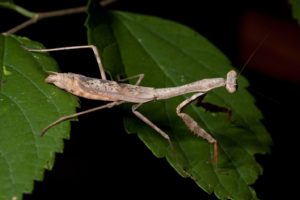
Public Domain,
https://commons.
wikimedia.org/w/index.
php?curid=7687857
By Casey Smith, Naturalist
My favorite insect must be the praying mantis. With their alien like faces and quick reflexes, they almost seem other-worldly. They are considered beneficial to man because of their affinity for eating insects that may be harmful to humans, though mantids don’t take this into consideration when finding their food. Mantids (the plural of mantis) can kill prey three times their size and strike twice as fast as the blink of an eye. They prey on insects, small turtles and snakes, mice, and some species have been known to catch and eat hummingbirds.
There are nearly 2,000 species of mantids in the world. Here in Ohio we have three species; the Carolina, the European, and the Chinese. The Carolina mantis is our native mantis. It’s small, pale green to brown, and can reach up to 2.5 inches in length. As the name suggests, the European mantis is not native to Ohio. It is similar in size to the Carolina mantis, reaching up to 2.75 inches in length. It can be identified by a black and white bullseye shape in its armpit. The Chinese mantis was introduced to the United States as pest control in the early 1900s. Since no one told it to stay put, it has spread across much of the United States. The Chinese mantis can reach up to 4.5 inches long, double that of our native mantis. It is thought that the Chinese mantis is outcompeting, and most likely eating, the Carolina mantis, and is the reason we don’t see many of our native mantids today. Even so, I still can’t help but get a little giddy when I cross paths with a monster Chinese mantis.
Adult mantids aren’t seen until later in the summer or early fall when they are out looking for mates. But you can watch for their egg cases, or ootheca, to be hatching soon. Young mantids spend the summer hunting, eating, growing, and hiding. Adult females lay their frothy brown egg sacs in late summer or early fall, then die a couple weeks later. Each egg case contains hundreds of eggs. Preservation Parks naturalists will be raising Chinese and Carolina mantids at Shale Hollow Park as part of the Adventures in Flight exhibit this summer, which opens May 26. Be sure to stop by to check them out and watch them grow, along with one species of exotic mantis, the ghost mantis!






